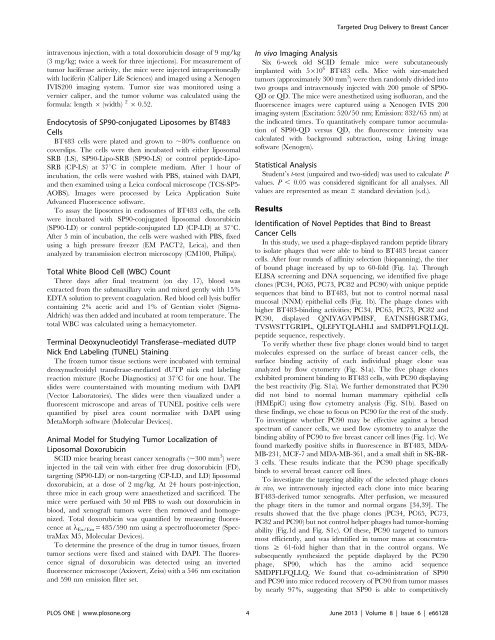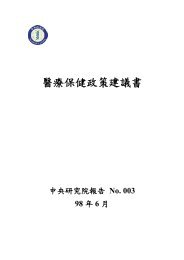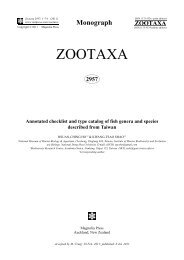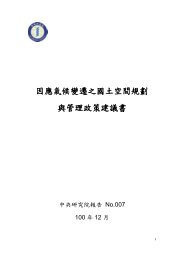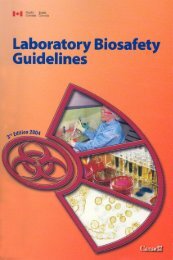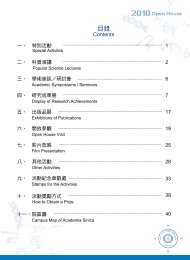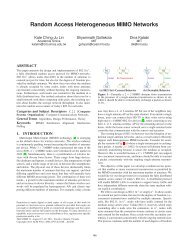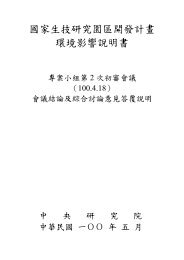Targeted Drug Delivery Systems Mediated by a ... - Academia Sinica
Targeted Drug Delivery Systems Mediated by a ... - Academia Sinica
Targeted Drug Delivery Systems Mediated by a ... - Academia Sinica
Create successful ePaper yourself
Turn your PDF publications into a flip-book with our unique Google optimized e-Paper software.
<strong>Targeted</strong> <strong>Drug</strong> <strong>Delivery</strong> to Breast Cancerintravenous injection, with a total doxorubicin dosage of 9 mg/kg(3 mg/kg; twice a week for three injections). For measurement oftumor luciferase activity, the mice were injected intraperitoneallywith luciferin (Caliper Life Sciences) and imaged using a XenogenIVIS200 imaging system. Tumor size was monitored using avernier caliper, and the tumor volume was calculated using theformula: length 6 (width) 2 6 0.52.Endocytosis of SP90-conjugated Liposomes <strong>by</strong> BT483CellsBT483 cells were plated and grown to ,80% confluence oncoverslips. The cells were then incubated with either liposomalSRB (LS), SP90-Lipo-SRB (SP90-LS) or control peptide-Lipo-SRB (CP-LS) at 37uC in complete medium. After 1 hour ofincubation, the cells were washed with PBS, stained with DAPI,and then examined using a Leica confocal microscope (TCS-SP5-AOBS). Images were processed <strong>by</strong> Leica Application SuiteAdvanced Fluorescence software.To assay the liposomes in endosomes of BT483 cells, the cellswere incubated with SP90-conjugated liposomal doxorubicin(SP90-LD) or control peptide-conjugated LD (CP-LD) at 37uC.After 5 min of incubation, the cells were washed with PBS, fixedusing a high pressure freezer (EM PACT2, Leica), and thenanalyzed <strong>by</strong> transmission electron microscopy (CM100, Philips).Total White Blood Cell (WBC) CountThree days after final treatment (on day 17), blood wasextracted from the submaxillary vein and mixed gently with 15%EDTA solution to prevent coagulation. Red blood cell lysis buffercontaining 2% acetic acid and 1% of Gentian violet (Sigma-Aldrich) was then added and incubated at room temperature. Thetotal WBC was calculated using a hemacytometer.Terminal Deoxynucleotidyl Transferase–mediated dUTPNick End Labeling (TUNEL) StainingThe frozen tumor tissue sections were incubated with terminaldeoxynucleotidyl transferase-mediated dUTP nick end labelingreaction mixture (Roche Diagnostics) at 37uC for one hour. Theslides were counterstained with mounting medium with DAPI(Vector Laboratories). The slides were then visualized under afluorescent microscope and areas of TUNEL positive cells werequantified <strong>by</strong> pixel area count normalize with DAPI usingMetaMorph software (Molecular Devices).Animal Model for Studying Tumor Localization ofLiposomal DoxorubicinSCID mice bearing breast cancer xenografts (,300 mm 3 ) wereinjected in the tail vein with either free drug doxorubicin (FD),targeting (SP90-LD) or non-targeting (CP-LD, and LD) liposomaldoxorubicin, at a dose of 2 mg/kg. At 24 hours post-injection,three mice in each group were anaesthetized and sacrificed. Themice were perfused with 50 ml PBS to wash out doxorubicin inblood, and xenograft tumors were then removed and homogenized.Total doxorubicin was quantified <strong>by</strong> measuring fluorescenceat l Ex/Em = 485/590 nm using a spectrofluorometer (SpectraMaxM5, Molecular Devices).To determine the presence of the drug in tumor tissues, frozentumor sections were fixed and stained with DAPI. The fluorescencesignal of doxorubicin was detected using an invertedfluorescence microscope (Axiovert, Zeiss) with a 546 nm excitationand 590 nm emission filter set.In vivo Imaging AnalysisSix 6-week old SCID female mice were subcutaneouslyimplanted with 5610 6 BT483 cells. Mice with size-matchedtumors (approximately 300 mm 3 ) were then randomly divided intotwo groups and intravenously injected with 200 pmole of SP90-QD or QD. The mice were anesthetized using isofluoran, and thefluorescence images were captured using a Xenogen IVIS 200imaging system (Excitation: 520/50 nm; Emission: 832/65 nm) atthe indicated times. To quantitatively compare tumor accumulationof SP90-QD versus QD, the fluorescence intensity wascalculated with background subtraction, using Living imagesoftware (Xenogen).Statistical AnalysisStudent’s t-test (unpaired and two-sided) was used to calculate Pvalues. P , 0.05 was considered significant for all analyses. Allvalues are represented as mean 6 standard deviation (s.d.).ResultsIdentification of Novel Peptides that Bind to BreastCancer CellsIn this study, we used a phage-displayed random peptide libraryto isolate phages that were able to bind to BT483 breast cancercells. After four rounds of affinity selection (biopanning), the titerof bound phage increased <strong>by</strong> up to 60-fold (Fig. 1a). ThroughELISA screening and DNA sequencing, we identified five phageclones (PC34, PC65, PC73, PC82 and PC90) with unique peptidesequences that bind to BT483, but not to control normal nasalmucosal (NNM) epithelial cells (Fig. 1b). The phage clones withhigher BT483-binding activities; PC34, PC65, PC73, PC82 andPC90, displayed QNIYAGVPMISF, EATNSHGSRTMG,TVSWSTTGRIPL, QLEFYTQLAHLI and SMDPFLFQLLQLpeptide sequence, respectively.To verify whether these five phage clones would bind to targetmolecules expressed on the surface of breast cancer cells, thesurface binding activity of each individual phage clone wasanalyzed <strong>by</strong> flow cytometry (Fig. S1a). The five phage clonesexhibited prominent binding to BT483 cells, with PC90 displayingthe best reactivity (Fig. S1a). We further demonstrated that PC90did not bind to normal human mammary epithelial cells(HMEpiC) using flow cytometry analysis (Fig. S1b). Based onthese findings, we chose to focus on PC90 for the rest of the study.To investigate whether PC90 may be effective against a broadspectrum of cancer cells, we used flow cytometry to analyze thebinding ability of PC90 to five breast cancer cell lines (Fig. 1c). Wefound markedly positive shifts in fluorescence in BT483, MDA-MB-231, MCF-7 and MDA-MB-361, and a small shift in SK-BR-3 cells. These results indicate that the PC90 phage specificallybinds to several breast cancer cell lines.To investigate the targeting ability of the selected phage clonesin vivo, we intravenously injected each clone into mice bearingBT483-derived tumor xenografts. After perfusion, we measuredthe phage titers in the tumor and normal organs [34,39]. Theresults showed that the five phage clones (PC34, PC65, PC73,PC82 and PC90) but not control helper phages had tumor-homingability (Fig.1d and Fig. S1c). Of these, PC90 targeted to tumorsmost efficiently, and was identified in tumor mass at concentrations§ 61-fold higher than that in the control organs. Wesubsequently synthesized the peptide displayed <strong>by</strong> the PC90phage, SP90, which has the amino acid sequenceSMDPFLFQLLQ. We found that co-administration of SP90and PC90 into mice reduced recovery of PC90 from tumor masses<strong>by</strong> nearly 97%, suggesting that SP90 is able to competitivelyPLOS ONE | www.plosone.org 4 June 2013 | Volume 8 | Issue 6 | e66128


